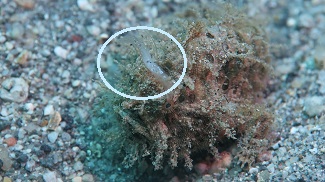Loading content - please wait...
Hairy frogfish video
Hairy frogfish video makes for compelling watching, especially one in which the fish actively lures potential prey. This video from Gorontalo shows a Hairy frogfish doing exactly that.
Striated or Hairy?
The scientific name of the fish in the Hairy frogfish video is Antennarius striatus. As such, it is commonly called Striated frogfish. This particular fish species has such a variable appearance that neither “striated” nor “hairy” accurately describe each individual found in nature. That includes the one in the video from Gorontalo. The fish’s environment determines its exterior appearance to a large extent. In fact, if a particular frogfish moves to a different environment, it will change appearance within three weeks to match. That means that the elongated blotches or the long filaments on the skin may not be apparent on any particular individual fish. It can sport almost any color.

Moreover, the best feature for positively identifying Antennarius striatus is its lure.
A Unique Lure
The first dorsal spine in many frogfish species is free moving. Called an illicium, this spine acts like a fishing pole. At the end of the illicium of Antennarius striatus is a fleshy lure. The unique lure or esca of this species of frogfish is long, extending perpendicularly from each side of the lure. Many descriptions of this frogfish say that the lure looks like a worm, However, that is not particularly true of the one seen in the Hairy frogfish video from Gorontalo. Take a look and notice its pale color and spots. This one looks more like a shrimp dancing above the rubble. When not in action, the lure will rest on the forehead of the frogfish.
Hairy Frogfish Video
As you watch this video from Gorontalo, notice the way the frogfish pulls itself along the sandy bottom. It is using its pectoral fins. This is a distinctive movement of various frogfish.
Judging by how active it is, both in flicking its lure and pulling itself to a new position, this frogfish is clearly hungry. It is on the hunt! Many frogfish species, including the Hairy frogfish, have a large mouth. As a result, a frogfish can extended its mouth forward and swallow prey as large as itself. That also means that its stomach has plenty of room.
Typically, frogfish lie motionless using its well-adapted coloration to remain unseen. The videographer never saw this Hairy frogfish catch anything. Perhaps too much movement was to blame.
Hairy frogfish usually eat other fish. Unlike other species of frogfish, the lure or esca of Antennarius striatus has an additional feature. It is able to secrete a scent that attracts unsuspecting prey to its wiggling lure. This species also can live in waters deeper than other frogfish species. It is found in seas worldwide, except in the Mediterranean and the Arctic. Although the individual seen in the video is very small, it can grow up to 22 centimeters in length.
Hairy frogfish are only found at a few of Gorontalo’s muck diving sites. This sites are best suited for experienced divers with excellent buoyancy control. For your chance to watch a Hairy frogfish in Gorontalo, please book your dive trip with us.






Sorry, comments are closed for this post.